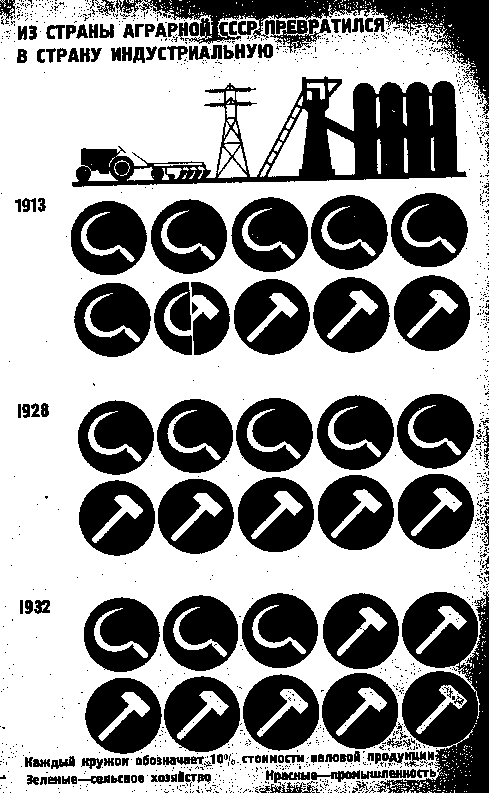The Disaster of Collectivization (1929-33)
Shown (unintentionally) in a Soviet Graph
"Look on my works, ye mighty, and despair!"
--"Ozymandias," by Percy Bysshe Shelley (1792-1822)
File added 990216
Latest update 990922
Copyright © 1999 by Hugo S. Cunningham
Translations
At top:
"The USSR transformed itself from an agrarian country into an industrial country."
At bottom:
"Each circle represents 10% of national product.
Sickle -- agriculture.
Hammer -- industry."
Source: Vsesoyuznyj Institut Izobrazitel'noj Statistiki Sovetskogo Stroitel'stva i Xozyajstva pri CIK SSSR ["All-Union Institute of Graphic Statistics of Soviet Construction and Economy for the CEC (Central Executive Committee) of the USSR"], Na Strojke Socializma: Dostizheniya Pervoj Pyatiletki ["Building Socialism: Achievements of the First Five Year Plan"], OGIZ-IZOGIZ, Moscow, 1933. Page 1
|

|
We are supposed to interpret the fall of agriculture's share from 50% in 1928 to 30% in 1932 as the reflection of huge growth (133%) in industry, rather than a fall in agricultural production. If one considers 133% industrial growth in just 4 years to be a fantasy, however, this graph would indicate a catastrophic fall in agricultural production (which indeed is what actually happened).
Nevertheless, one should not try to go far with this analysis. Soviet graphics, especially public ones, were intended for inspiration, not accurate disclosure.
A quote from the young Lenin on the advantages of famine
Should post-Communist Russia reverse collectivization?
Not necessarily. Even though Collectivization was a disaster, wiping out the most productive and talented farmers, history cannot automatically be reversed.
(1) The family-farm model, so appealing in the USA and Canada in the 1920s and 1930s, has increasingly been supplanted by corporate farming; a well-run collective or cooperative farm is not automatically worse than a well-run corporate farm.
(2) Stalin was quite successful in crushing innovative spirit in the peasantry. Hastily-divided collective farms are not automatically going to find their way into the hands of productive and entrepreneurial go-getters.
(3) One should not idealize the pre-1929 Soviet countryside as a Ukrainian Iowa. Peasants worked their own land, but were jealous of outsiders and oblivious to property rights. Entrepreneurs who tried to hold on to their own land for intensive and scientific cultivation were viewed with envy and suspicion.
Return to discussion of "Revisionist" views of Soviet history.
Return to Theodore Dreiser page.
Denounce the graphic artists for sabotage and anti-Soviet propaganda!
Return to main page of the Cyber-USSR
